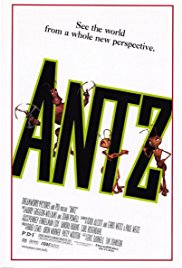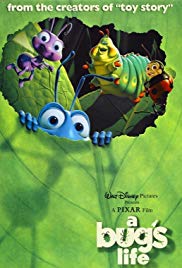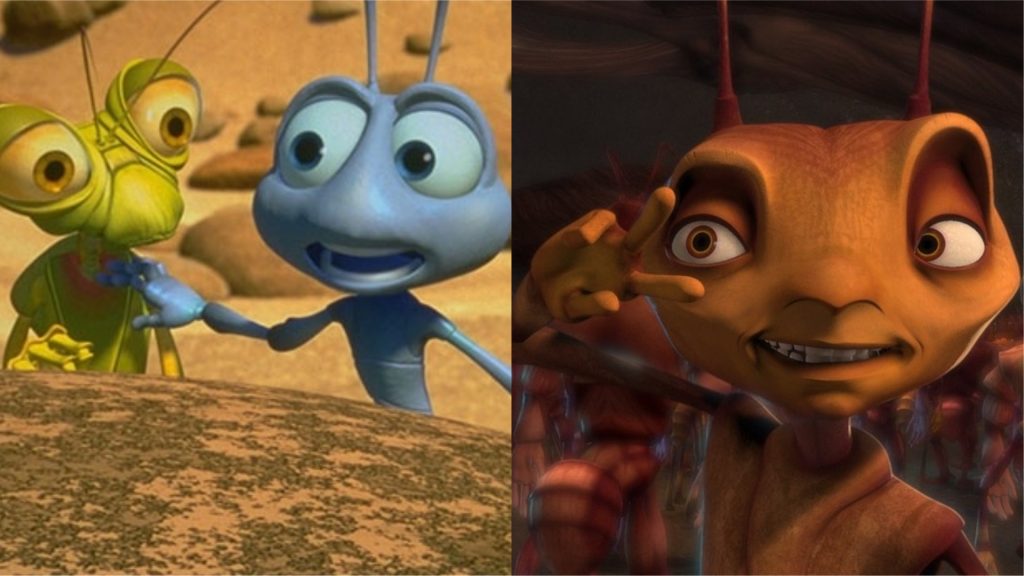SUBJECTS:
Science-Technology;
SOCIAL-EMOTIONAL LEARNING:
Friendship;
MORAL-ETHICAL EMPHASIS:
Respect; Responsibility.
There is NO AI content on this website. All content on TeachWithMovies.org has been written by human beings.

SUBJECTS:
Science-Technology;
SOCIAL-EMOTIONAL LEARNING:
Friendship;
MORAL-ETHICAL EMPHASIS:
Respect; Responsibility.

TWM offers the following movie worksheets to keep students’ minds on the film and to focus their attention on the lessons to be learned from the movie.
Film Study Worksheet for ELA Classes; and
Worksheet for Cinematic and Theatrical Elements and Their Effects.
Teachers can modify the worksheets to fit the needs of each class.
Each film describes the adventures of a nonconformist ant who, because of his differences from other ants, is able to save the colony. For children ages, 5 – 8, see A Bugs Life – Talking and Playing for Growth.
Selected Awards:
1999 ASCAP Film and Television Music Award; 1999 Motion Picture Sound Editors, USA: Best Sound Editing.
Featured Voices:
Woody Allen, Sharon Stone, Gene Hackman, Sylvester Stallone, Christopher Walken, Dan Aykroyd, and Danny Glover.
Director:
Eric Darnell and Lawrence Guterman.
Selected Awards:
1999 Blockbuster Entertainment Awards: Favorite Animated Cast Film Critics Association Awards: 1999 Academy Awards Nominations: Best Music; 1999 Chicago Film Critics Association
Awards Nominations:
Best Original Score; 1999 Golden Globe Awards Nominations: Best Original Score; 1999 Young Artists Awards Nominations: Best family feature-animated; Best Performance in a voice over (Panettiere)
Featured Voices:
Julia Louis-Dreyfus, Kevin Spacey, Phyllis Diller, Joe Ranft, David Hyde Pierce, John Ratzenberger, Roddy McDowell and Hayden Panettiere.
Director:
John Lasseter and Andrew Stanton.
These animated features contain lessons in the value of nonconformity and friendship. They can also be used to interest children in the study of ants.

Ask and lead your children through the questions and answers relating to Respect. Ask your children what a decomposer is and what role decomposers play in the environment. Tell them that ants are great decomposers. This Learning Guide contains interesting information about ants in the Helpful Background section. You can go over it with your kids.
There are 8800 known species of ants. Most species are located in the tropics. Ants are found in all regions of the world except for the polar regions and places with extremely high altitudes. Ants are such a successful species because their collective mastery of social organization allows flexibility in their approaches to survival.
An ant can lift 5 times its weight and drag an object 25 times its weight. An ant has two sets of jaws: one for holding things that it carries and one to chew food.
Ants contribute to the population control of their prey, recycling of plant material, aeration of soil, seed dispersal, and several other major ecological processes. Ants are “decomposers,” i.e., they help the environment recycle matter from dead plants and animals. While different species of ants have different preferences in food, ants as a species are omnivores, i.e., they will eat both plants and animals.
Some ants are farmers. Ants living in the southeastern United States and in tropical Central and South America cultivate a fungus in their nests. To feed the fungus, the ants cut sections of leaves and take them to the nest. (See Photograph of leaf-cutter ants.) Honey Pot ants keep herds of aphids which they tend and stroke to encourage the aphids to emit “honey dew” a sweet liquid that the ants use for food. Ants will move the aphids into the ant hill during cold weather. Honey Pot ants store surplus honey dew in the bodies of other ants. The food is kept in a separate stomach and then regurgitated to another ant when needed. Some species of ants also keep scale insects and lycaenid butterfly larvae as domesticated animals. Red harvester ants (central United States and Mexico) frequent fields of grass, harvesting and storing the grass seeds.
Some ants engage in slavery. The Amazon ant will attack the nests of other ants. The brood ants who are not eaten will be required to serve as slaves when they mature to excavate, brood-tend or perform other work. Another species of ant has a queen that permits herself to be dragged into the nest of another type of ant, then kills the queen. The host colony then cares for and hatches the eggs of the new queen.
Ants have four life stages: egg, larva, pupa, and adult. What are commonly referred to as “ant eggs” are really the pupae. There are two types of ants in any nest: reproductive and nonreproductive. The queen and males constitute the reproductive class of ants. The non-reproductive ants include the female worker ants.
Army and driver ants make nests that consist of the clustered bodies of millions of workers hanging from the underside of a raised log or other surface. Enclosed in this mass are the queen and the brood.
If a line of ants taking food to its nest and returning for more is interrupted by the placement of an obstacle that breaks up the line, the ants will find the shortest way around the obstacle and reestablish the line of march. See How Ants Find the Shortest Route Around an Obstacle.
Each day, colonies of army ants in the Amazon or driver ants in Africa organize a swarm raid. These raids have fronts that reach more than 45 ft in width. Advancing at a rate of about 12 inches a minute, these ants tear apart or capture and then take to their temporary nests any prey that cannot escape them. Their food consists primarily of spiders or other insects, although snakes, baby birds, or other small vertebrates are sometimes killed by stinging and brought back to the nest.
The biomass of the ants in the Amazon forest is estimated to be four times the biomass of all the vertebrate animals combined. Biomass means the total amount of living matter.
Ants do not have lungs, but rather tiny tubes that carry air to all portions of their bodies.
1. See Discussion Questions for Use With any Film that is a Work of Fiction.
2. What do you like best about ants? What do you like the least about ants?
3. Why are ants such a successful species?
4. Tell us the purpose of the major structures of an ant’s body: antenna; mandible; abdomen; and petiole.
5. Name some changes that different types of ants cause in their environment.
6. What is a “decomposer” and how does that term apply to ants? What role do decomposers play in the environment?
7. Are ants “herbivores,” “carnivores,” or “omnivores”?
Suggested Response:
Ants are omnivores, although different species of ants may prefer to eat different types of food.
8. Where do ants fit into the ecology of any environment they are in?
Suggested Response:
They are decomposers, helping the environment recycle matter from dead plants and animals.
9. Do ants have a place in the food chain in our environment? If so, tell us where they fit?
10. Are ants a beneficial insect in the rainforest? Are they beneficial in a savannah environment? Are they beneficial in our environment? For each, tell us in what way ants are beneficial. Does the answer to this question depend upon what type of ant you are talking about?
Suggested Response:
Ants are decomposers in all environments and they are beneficial to all environments. It doesn’t matter what type of ant.
11. Are ants pests in the rainforest? Are they a pest in a savannah environment? Are they pests in our environment? For each, tell us in what way ants are a pest. Does the answer to this question depend upon what type of ant you are talking about?
Suggested Response:
Ants are pests in homes and buildings.
12. How do ants breathe?
13. How do ants digest food, dispose of bodily wastes, and transport materials within their bodies?
14. Do ants have any of the following: teeth, an esophagus, a stomach, intestines, kidneys, blood, lungs, eyes, or ears? If they have any of these structures, how do those structures differ from ours?
15. Do ants need water to survive?
16. Are worker ants male or female?
17. Which species is more successful: mankind or ants? For one scientist’s answer, see The Answer. Is this a valid comparison? How would you answer this question?
1. What was the role of friendship in this movie and its relationship to the ultimate outcome?
2. What was the strongest act of friendship shown in this film?
See the “Caring” section below for more questions on this topic.
Discussion Questions Relating to Ethical Issues will facilitate the use of this film to teach ethical principles and critical viewing. Additional questions are set out below.
(Treat others with respect; follow the Golden Rule; Be tolerant of differences; Use good manners, not bad language; Be considerate of the feelings of others; Don’t threaten, hit or hurt anyone; Deal peacefully with anger, insults, and disagreements)
1. What would have happened to the ant colony had the hero been just like all the other ants?
Suggested Response:
The colony would have died because the hero was the only one with the solution and that solution grew out of the differences between him and the other ants.
2. What does this film make you think about people who are different from other people?
Suggested Response:
Everyone has the right to be respected, even people who are different. Their differences may just save the day.
(Do what you are supposed to do; Persevere: keep on trying!; Always do your best; Use self-control; Be self-disciplined; Think before you act — consider the consequences; Be accountable for your choices)
3. The ant colony was not very nice to the hero in the film. Should he have continued to help the colony?
(Be kind; Be compassionate and show you care; Express gratitude; Forgive others; Help people in need)
4. What was the role of caring in the plot of this film? What would have happened to our hero had certain people in the colony not expressed their friendship for him?
5. Can someone be a friend to someone else if they don’t really care for them and if they are not willing to go out of their way to help them?
1. Assignments, Projects, and Activities for Use With any Film that is a Work of Fiction;
2. Children can be asked to give a presentation or write a paper on any of the discussion questions;
3. The group can build an ant colony;
4. Children can draw an ant on a large scale, showing in the drawing the different structures in an ant’s body; and
5. Stage a “Science Bowl” game in which teams compete to see who knows interesting facts about ants.
There are thousands of books on ants. Ask your local librarian.
This Learning Guide was last updated on July 21, 2013.